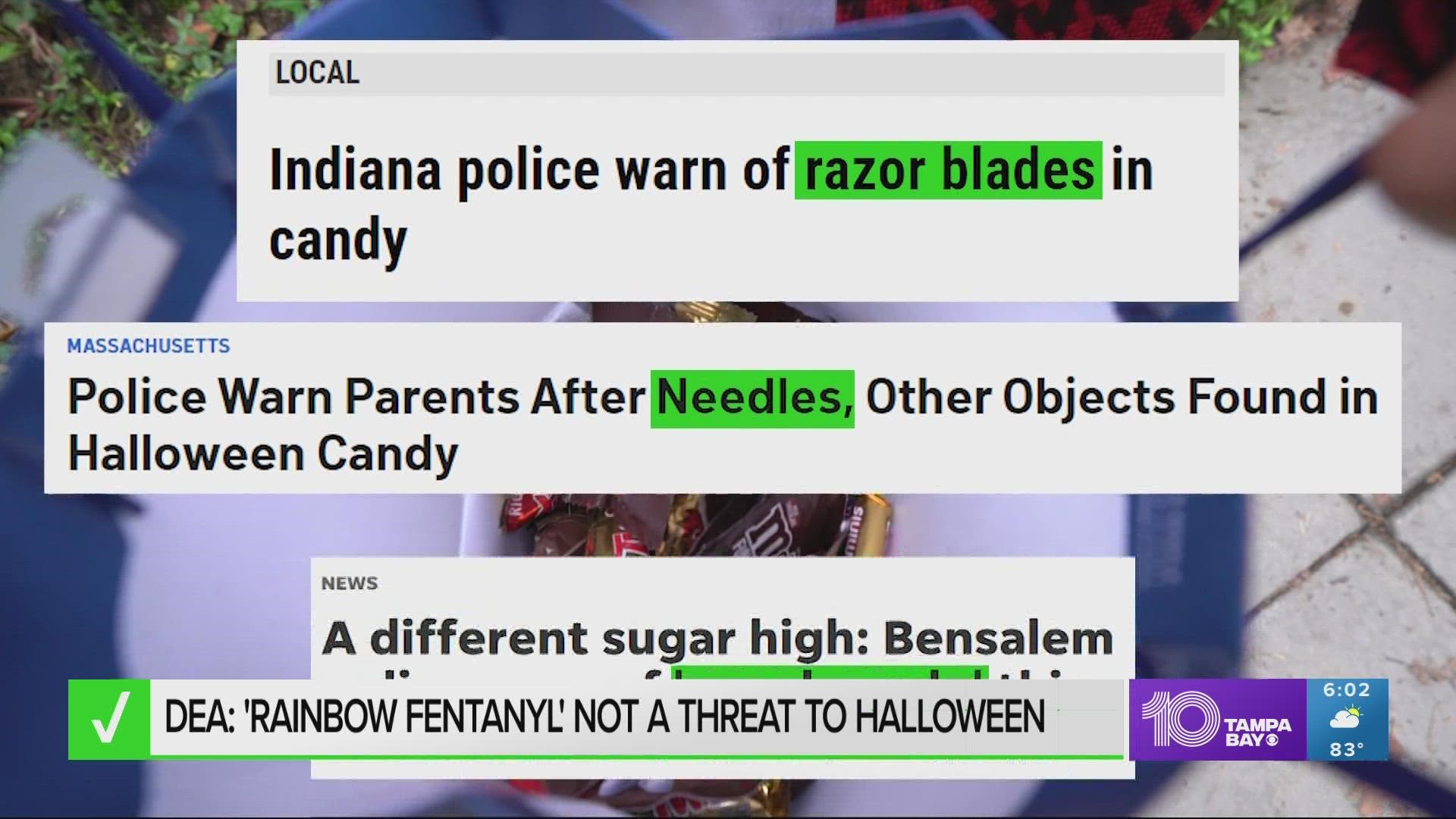ST. PETERSBURG, Fla. — From razor blades to poison pills disguised as sweets, reports and innuendo seemingly swirl every year in October about the potential danger that could be lurking in the Halloween candy your kids collect while trick-or-treating.
The focus this year has been on so-called “rainbow fentanyl,” brightly colored pills of the powerful and deadly synthetic opioid.
The Drug Enforcement Administration warned on Aug. 30 about the “emerging trend” of these colored fentanyl pills, which the agency described as a “deliberate effort by drug traffickers to drive addition amongst kids.”
That initial release made no mention of Halloween, but politicians from Senate Republicans to Democratic Senate Majority Leader Chuck Schumer have followed up with their own warnings specific to the holiday.
It is true that illicit fentanyl has become one of the most common drugs involved in overdose deaths, according to the Centers for Disease Control and Prevention. It’s estimated more than 150 people die each day from an overdose related to fentanyl or other synthetic opioids.
THE QUESTION
But is there any credible evidence traffickers are targeting Halloween and your kids’ candy with “rainbow fentanyl” pills?
THE SOURCES
- Drug Enforcement Administration (DEA)
- Dr. Ryan Marino, medical toxicologist at University Hospitals Health System
- Joel Best, professor of sociology and criminal justice at the University of Delaware
THE ANSWER
There is no credible evidence traffickers are targeting Halloween and your kids’ candy with “rainbow fentanyl.”
WHAT WE FOUND
VERIFY followed up with the DEA about its August press release warning about brightly colored fentanyl pills being used to target young Americans.
DEA spokesperson Erin Knight-Grimming with the agency’s Miami field division told VERIFY they have not seen any credible evidence that indicates “rainbow fentanyl” is related to Halloween.
She referred VERIFY to recent statements made by DEA Administrator Anne Milgram in interviews with NBC and FOX News in which Milgram said the agency has not seen credible evidence that drug traffickers are putting “rainbow fentanyl” into Halloween candy.
“If that changes, we will be sure to alert the public,” Knight-Grimming said, adding, “we have seen children as young as 12 poisoned by fentanyl so we encourage families to educate themselves about the dangers of fentanyl, regardless of what color, size, shape or form it comes in.”
While experts acknowledge fentanyl is a public health problem, they say legitimate reports of children being harmed by contaminated Halloween candy are best understood as contemporary legends or urban myths.
Joel Best tracks media coverage of reported incidents involving contaminated Halloween candy. His reports on what he refers to as “Halloween sadism” has appeared in the New York Times, the Los Angeles Times, the Chicago Tribune and the Fresno Bee.
In data going back as far as 1958, he says he’s not found one incident of a child being killed or seriously hurt by contaminated candy picked up during trick-or-treating.
“Halloween is supposed to be scary, so we've stopped believing in ghosts and goblins, and we believe in criminals,” Best said.
The focus on “rainbow fentanyl” this year didn’t surprise Best who said these concerns of tainted treats usually follow reported crime trends in the news.
For example, similar fears surfaced in the early 1980s after several people died taking tainted Tylenol in September, Best told VERIFY. Following the 9/11 attacks, rumors swirled about terrorists buying candy in bulk to poison and then pass off to children.
Best argues there’s a certain level of irrationality to it all mainly because drugs cost more than candy.
“Are they going to then become addicted and give you their lunch money,” Best said. “I mean, what's the marketing plan? This is completely implausible.”
Dr. Ryan Marino, a medical toxicologist and addiction specialist at University Hospitals Cleveland Medical Center, said while fentanyl is a serious and deadly problem, suggesting it’s a Halloween problem is a disservice.
“There is a lot of misinformation out there,” Marino said, pointing to similarly disproven concerns that people can overdose on fentanyl simply by touching it.
“This distracts from real conversations, this keeps people from actually being safe, and it takes away from actual things that we could be doing that would make a big difference here.”
According to the American Academy of Pediatrics, the biggest threat to children on Halloween is being hit and injured by a car.
The U.S. Food and Drug Administration (FDA) has a list of tips to ensure trick-or-treating is safe, like not accepting or eating any candy that isn't commercially wrapped.

